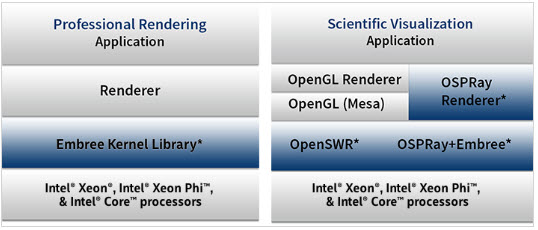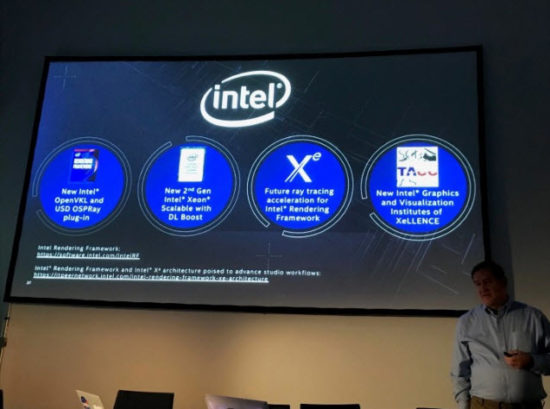Accelerating everything, all in on open source, and revolutionizing workflows.
At FMX, Intel’s Sr. Principal Engineer, Sr. Director, Advanced Rendering and Visualization, presented updates on Intel’s Rendering Framework which includes the open source tools and libraries of Embree and OSPRay, Open SWR, and the Open Image Denoise tools. Jeffers notes that the AI/ML based Open Image Denoise is available for integration into any program, but that it is also integrated into Embree and OSPray. Using these tools, developers can build their own ray tracing apps, and Jeffers notes that the technology has been widely accepted by the studio community including Disney’s Dreamworks MoonRay renderer.
At FMX, Jeffers announced the addition of OpenVKL (open volume kernel library) which enables volume rendering, which comes into play for scientific visualization, as well as particle systems for entertainment content, and simulations for cosmology, weather, geology, and more.
Also, new is the release of the Hydra OSPRay plug-in built on Universal Scene Description (USD) introduced by Pixar for 3D content exchange. The Hydra plug-in enables interactive photorealistic global illuminated previews in Hydra capable applications including Autodesk’s Maya. Processing can scale over multiple server notes for faster frame rates, higher visual quality. By taking advantage of Intel’s denoising technology, very large data sets including multi-frame animations can be rendered in realtime.

Intel’s Rendering Framework libraries include:
- Embree, a ray tracing kernel library adopted by more than 80 independent software vendors (ISV) for its extensibility (64- and 32-bit Windows, macOS 10.x, Linux support), and vast feature set for complex rendering and shading frameworks. Recently added is Catmull-Clark subdivision with hair, curves, Bspline, motion blur for temporal resolution for multiple scenes elements, which, Jeffers points out, is not simple linear motion blur.
- OSPRay, a cluster-capable, scalable, extendable, ray tracing, rendering toolkit that includes path tracing and volume rendering. It efficiently uses threading and vectorization to create interactive, high-fidelity applications on CPUs from Intel.
- OpenSWR (software rasterizer), an OpenGL low-level rasterization library upstreamed to the Mesa OpenGL open source project to achieve high rendering performance when GPUs are unavailable or are too limiting.
- Open Image Denoise, an open source library of image denoising and filtering algorithms to improve visual quality and reduce rendering times.
The Intel Rendering Framework is a software-defined visualization (SDV) approach for supporting big data use on platforms of all sizes, including cloud and high-performance computing (HPC) clusters. This, brags Intel, is achieved by enabling the parallelism and performance already in x86 CPU-based Intel platforms without the memory limits and cost of GPU-based solutions.

More importantly, Intel has collaborated with hardware and software providers to design Intel Select Solutions for Professional Visualization. These are turnkey solutions which Intel says provide an out-of-the-box experience for combining computationally intense codes with photorealistic rendering and visual analysis tools used in science, manufacturing, professional rendering, architecture, gaming, and more.
Xe coming closer. Intel’s Xe architecture, which underlies its GPU strategy, is coming next year. The philosophy behind Xe and Intel’s strategy is to leverage the strengths of both CPUs and GPUs.
Intel brags that their x86 architecture offering large memory capability and performance engines for visual effects and animated feature films and points out that GPUs have architecture limitations in memory size. Nonetheless, studios continue to reach for maximum realism with complex physics processing for cloth, fluids, hair and more, plus modeling the physics of light with ray tracing, which are parallel operations and benefit from GPU architectures. So, Intel says that what applications really need are mixed parallel and scalar computing while still having the ability to accommodate growing memory footprints. Xe, says Intel, is part of a holistic platform design where computational tasks are distributed to the most appropriate processing resources. And added to the mix is Intel’s Optane persistent memory which offers local non-volatile memory in terabytes—everything a big-data visualization organization could want.
At FMX, Jeffers revealed more details about the Xe architecture roadmap including ray tracing hardware acceleration for Intel’s Rendering Framework family of APIs and libraries. The work Intel has done on open source products will carry over to Intel’s new products coming as part of the Xe release and those APIs will benefit from the new “flexible accelerated platforms.” In addition, Jeffers points out that ray tracing as a general computational technique has applications beyond rendering and will be valuable for HPC applications. Jeffers says, Intel is creating a holistic software and compute environment to maximize workflow for exponential benefits.
“To put it succinctly in my own words,” said Jeffers, “Leave no transistor behind.”

What do we think?
Intel has a big presence in the big-data visualization field stretching from geophysical exploration to movie making (Embree is in over a dozen block-buster movies). However, users have been on their own when the time came to try and get a heterogeneous system running so they could exploit the benefits of a GPU or other processors like FPGAs. Intel is closing that gap and removing some of that pain and when the Xe GPU AIBs are available next year Intel will include them in its bag of visualization and rendering solutions, and it will be backward compatible so no data will be left behind.





